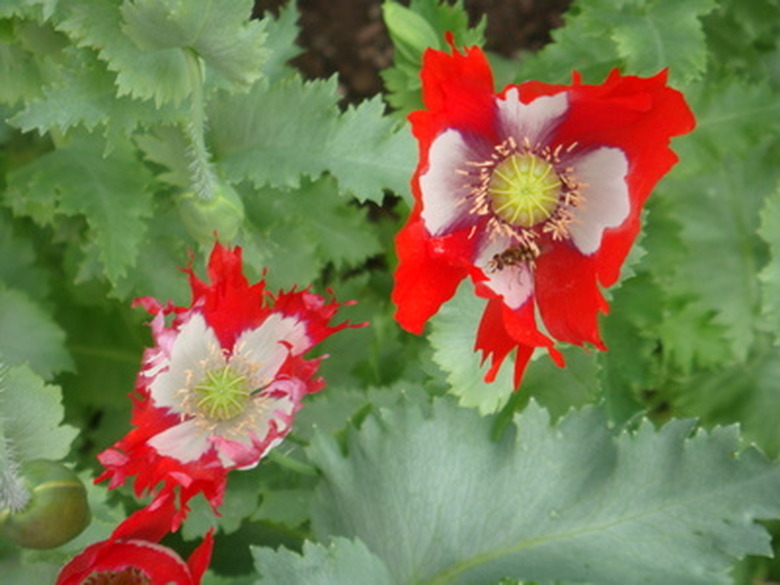How To Grow Oriental Poppies In Ohio
Things Needed
- Peat pots
- Seed-raising mix
- Sprayer bottle
- Ceramic dish or tray
- Oriental poppy seeds
- Pencil or spoon
- Shovel
- Compost
- Rototiller or garden fork
- Metal rake
- Garden trowel
- Scissors
Oriental poppies (Papaver orientale) are perennial growing plants that bloom from late spring to early summer. Most of Ohio falls in the U.S. Department of Agriculture (USDA) planting zones 5 and 6. Oriental poppies will grow in USDA zones 3 to 8, which makes them a beautiful addition to any Ohio garden. Plan on starting oriental poppy seeds indoors about five to six weeks before spring.
Planting Oriental Poppy Seeds
Step 1
Fill up 4-inch wide peat pots to 1/2 inch from the top with seed-raising mix. Mist the seed-raising mix with water to thoroughly dampen it down.
Step 2
Put the 4-inch pots on a ceramic plate or in a shallow plastic container.
- Oriental poppies (Papaver orientale) are perennial growing plants that bloom from late spring to early summer.
- Oriental poppies will grow in USDA zones 3 to 8, which makes them a beautiful addition to any Ohio garden.
Step 3
Place two to three oriental poppy seeds on the surface of the seed-raising mix in each of the 4-inch peat pots.
Step 4
Press the oriental poppy seeds into the seed-raising mix using the eraser end of a pencil, the back of a metal spoon or your fingertips.
Step 5
Sprinkle over the top of the oriental poppy seeds a shallow layer of seed-raising mix, around 1/8 of an inch. Then spray a fine mist of water over the surface of the soil.
Step 6
Set the plate or tray of peat pots where the temperature is around 55 to 60 degrees. Direct sunshine should be avoided, but try and provide eight to 10 hours of filtered light daily. Keep the soil in the peat pots moist by spritzing with water as needed. Germination will begin in about seven to 10 days.
- Place two to three oriental poppy seeds on the surface of the seed-raising mix in each of the 4-inch peat pots.
- Sprinkle over the top of the oriental poppy seeds a shallow layer of seed-raising mix, around 1/8 of an inch.
Step 7
Transplant the oriental poppy seedlings. After they are about 2 inches tall and there is no more frost in your growing area, you can plant the poppy seedlings outdoors. For southern Ohio, transplant after the second week of May; northern Ohio, after the first week of June; and for central Ohio, after the third week of May.
Transplanting Oriental Poppies
Step 1
Dig up the area for the oriental poppies with a shovel down to a depth of 10 to 12 inches. For areas of central Ohio that are known for having heavy clay soil, amend it to help improve drainage. Spread out a 2- to 3-inch layer of compost over the planting area, and mix it into the soil thoroughly using a shovel, rototiller or garden fork.
Step 2
Level and smooth out the planting area using a metal rake.
- Transplant the oriental poppy seedlings.
- Spread out a 2- to 3-inch layer of compost over the planting area, and mix it into the soil thoroughly using a shovel, rototiller or garden fork.
Step 3
Dig planting holes with a garden trowel that are the same width and depth of each peat pot. Space each planting hole 10 to 12 inches apart.
Step 4
Soak the peat pots in water for about 30 minutes to soften them up. With scissors, cut off the top section of each peat pot down to the soil line to eliminate any water loss.
Step 5
Place a seedling into a planting hole. Scoop soil in and around the oriental poppy seedling to fill the hole. Then, tamp the soil down firmly around each seedling.
- Dig planting holes with a garden trowel that are the same width and depth of each peat pot.
Step 6
Water the poppies during the summer only if there is no rainfall. Otherwise, water once a week and let the soil dry out in between watering.
Tip
According to Michigan State University Extension, plant oriental poppies in full sun and provide good-draining soil. After the first frost, spread a 4- to 6-inch layer of pine bark, straw, grass clippings or similar for mulch over the oriental poppies.
